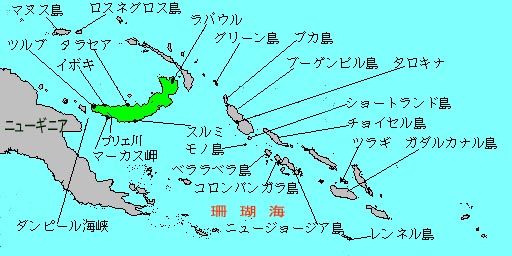Distance from Guadalcanal
| Hebrides | Rabaul |
| Distance | 1,300km | 1,100km |
IJN planed FS Operaion after initial invasion of Rabaul. The aim of FS Operation was to cut communication between Australia and US. Letter F was Fiji, and Letter S was Samoa. IJN prolonged FS Operaion two months, though IJN lost 4 aircraft carriers. IJN judged that FS operation could do without aircraft carriers. I do not know why IJN judged. IJN engineer corps landed on Guadalcanal on 6 July 1942. IJN built an airstrip of 800x60 m on 5 August[7]. US joint board decided that Nimitz controlled forces to occupy near Santa Cruz Islands on 2 July. Nimitz was surprised that a patrol aircraft discovered an airstrip under construction. US Marines landed on 7 August and occupied the next day. Guadalcanal is wide of Aichi of Japan or Chichagof Island of US. USN succeeded in ferry supply on 15 August. The aircraft carrier, USS Long Island (AVG-1, later CVE-1) catapulted 19 F4F of VMF-223 and 12 SBD of VMSB-232 off Guadalcanal on 20 August 1942. They flew 300km and landed on Guadalcanal. Rabaul is 1,450km from Truk. While Hebrides is 610km from Noumea. But Noumea is 6,300km from Honolulu. Although IJN could not supply well without air cover, I suppose that USN supply planning was better than IJN. Japan lost 39 merchant ships of 200 kGT from August 1942 to February 1943 till IJA withdraw from Guadalcanal.
Goeikubo, p225
Ouchi, p32
F4F, p50
|
Lost ships near Guadalcanal A:Army, B:Navy
| Date | Kind | Kanji | GT | Company |
| Oct16 | A | 笹子丸 | 9,258 | Nippon Y. |
| Oct16 | B | 吾妻丸 | 9,258 | Nippon Y. |
| Nov14 | A | ありぞな丸 | 9,683 | Osaka S. |
| Nov14 | A | かんぺら丸 | 6,477 | Osaka S. |
| Nov14 | A | ぶりすべーん丸 | 5,425 | Osaka S. |
| Nov14 | A | 長良丸 | 7,149 | Nippon Y. |
| Nov14 | A | 那古丸 | 7,145 | Nippon Y. |
| Nov14 | A | 鬼怒川丸 | 6,936 | Toyo K. |
| Nov15 | A | 宏川丸 | 6,872 | Kawasaki |
| Nov15 | A | 山浦丸 | 6,798 | Yamashita |
| Nov15 | A | 山月丸 | 6,438 | Yamashita |
The right table shows the loss of Japanese merchant ships near Guadalcanal.
Japan lost two merchant ships on 16 October, though IJN had 51 Zeros, 13 bombers and 36 Betties on 20 October 1942 in Rabaul. While US had 35 fighters and 7 bombers only because of the damage by battleship bombardment.
US had 200 aircraft in Gudalcanal and New Hebrides, and also 200 in Port Moresby in November. IJN had 67 Zeros, 27 bombers and 64 Betties in November. IJN had 41 Zeros, 23 bombers and 36 Betties only in the end of November. Japan lost 9 fast merchant ships on 14 and 15 November, though famous Tanaka escorted the convoy.
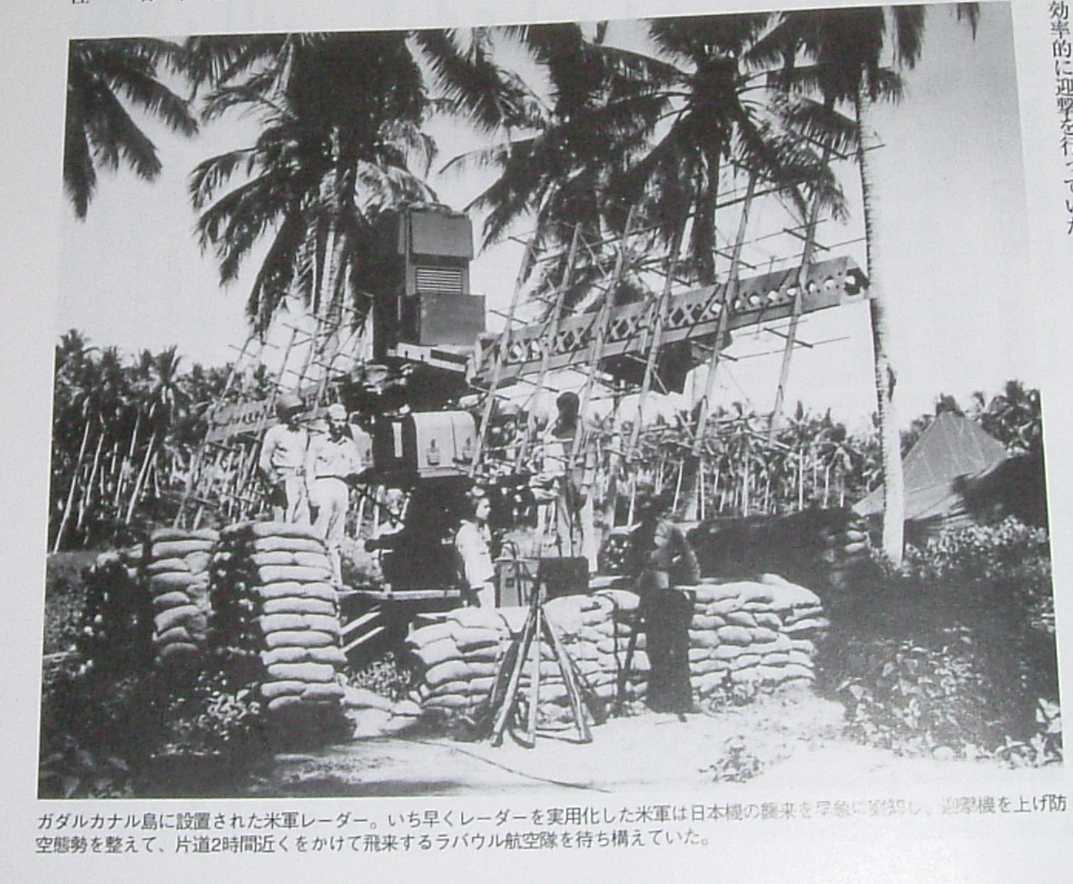 | 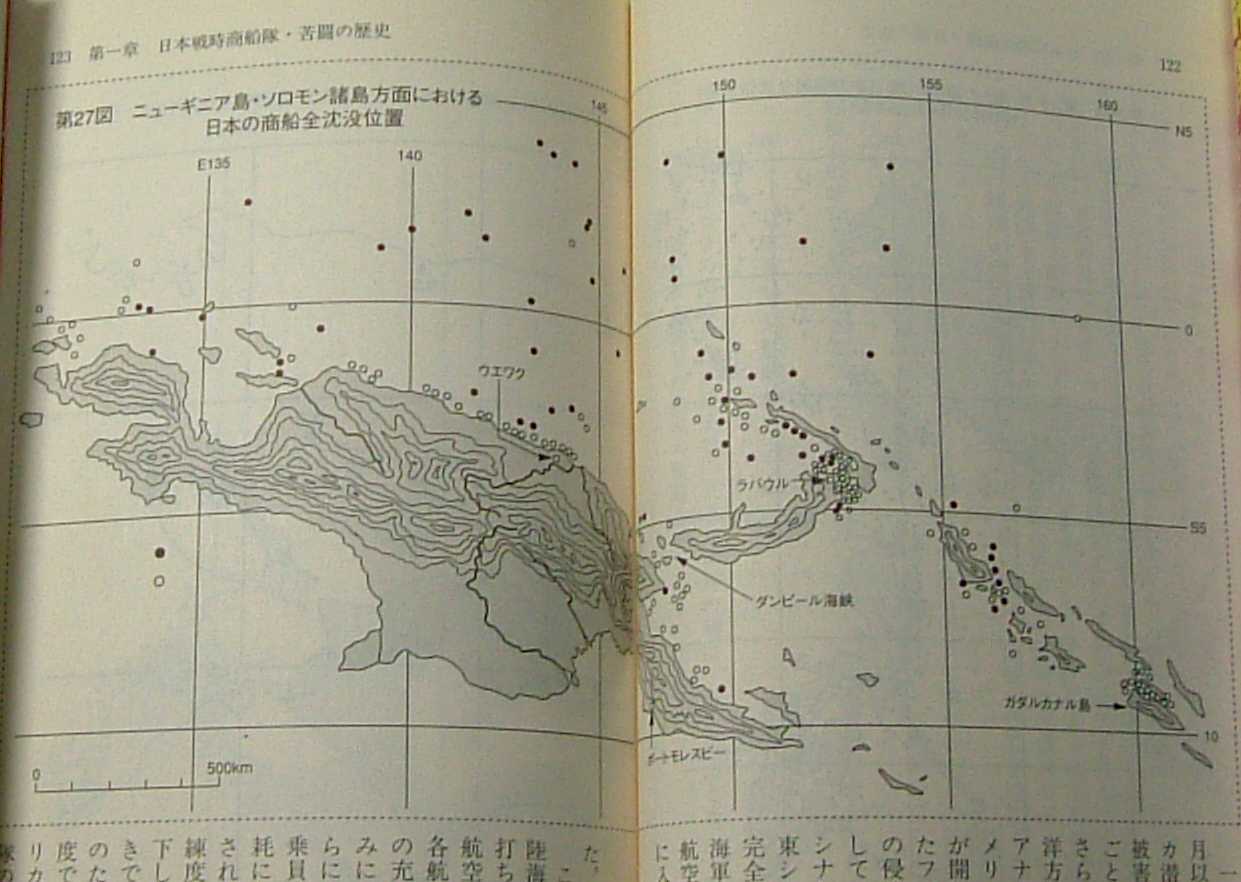 |
| US warning radar | lost merchant ships |
Tanaka commanded 11 destroyers ( Hayashio, Kuroshio, Oyashio, Kasumi, Arare, Kagero, Shiranui, Umikaze, Yamakaze, Kawakaze, Suzukaze ) to escort a convoy of 11 merchant ships which held 17,500 soldiers, 176 guns, ration of 30 days[4]. The convoy depearted from Short land. The convoy spotted an enemy aircraft in the early morning on 14 November. The convoy lost 6 merchant ships by US aircraft till 1600 on the day, though IJN did 36 Zero sorties, 14 seaplane sorties. A merchant ship returned and was escorted by two destroyers. Six destroyers saved 4,802 soldiers and crews. Sunset was 1730. The time is JST or unknown. Tanaka commanded four destroyers and four merchant ships now. The four merchant ships (鬼怒川丸, 宏川丸, 山浦丸, 山月丸) were on shore before dawn[1].
2100 The convoy followed 2th fleet off 7 km and passed in the north of Sabo Island.
2130 IJN aircraft reported that it found 2 cruisers and 4 destroyers
2200 IJN Shikinami spotted enemy in the south
2231 IJN Atago spotted enemy
2252 USS Washington deteced enemy by radar
2312 Lee spotted enemy
2317 USS Wasington and South Dacota opened fire at range of 8,000m
2339 Kondoh spotted the convoy
2350 IJN Takao reported an enemy battleship
2357 IJN Nagara reported that the enemy was 2 battleships, but Kondoh judged wrong
2400 Tanaka ordered 3 destroyers to attack, Kondoh recognized the enemy were battleships
0001 Kondoh opened fire against USS South Dacota at range of 6,000m
0032 Lee ordered to retreat
0043 Kondoh ordered to stop attack on airfield
0104 Kondoh ordered to retreat[3]
0230 The convoy arrived off Tassafuronga
0500 Tanaka ordered them on shore[2]
Map of NE Guadalcanal
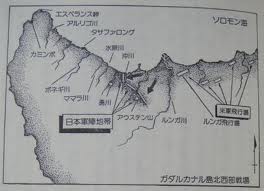 |
US warships, aircraft and army guns burned them after sunrise. No wounded 2,000 soldiers could land[6], but supply was very few. IJA could hold only 38 guns of 176. Why could Kondoh or Yamamoto stop the operation like MO operion of Inoue? If a ground force lost more than half of ground armament, IJA recognized wipeout. No one was responsible for the loss in IJN. It rarely seems that IJN thought of air cover for IJA serious. Actually aircraft carrier Jyunyo escorted battleship Kirishma then. Should Jyunyo locate the posion to support both of the convoy and the gun group? While USS Enterprise attacked the convoy in the slot, though Enterprise was damaged and could only a elevator. Enterprise accompanied a workship to repair her. Or did IJN think it like the Midway Battle? When a convoy was found by US aircraft in the Midway, a staff of GF told that the convoy was a bait. IJN failed an amphibious operation to occupy Wake Island without destroying F4Fs before. Land-based aircraft could not destroy an airstrip. Only aircarft of carriers could swept the F4Fs[5]. USN could defend Guadalcanal with cooperation of a few aircraft carriers and various vessels. USN proved that aircraft was important to attack warships and merchant ships to defend an island.
The right photo shows lost Japanese merchant ships in the Solomons Islands. I counted 14 dots. But it seems that location of spots are not correct near Guadalcanal. IJA was troubled with shortage of ammos. Soldiers were in hunger. Originally IJA opposed the invasion of the Solomons. A lot of IJA soldiers died of hunger because IJN could not defend merchant ships which were attacked by US and Australian aircraft. The left shows a US warning radar in Guadalcanal.
Gunzo, p33-49 Vol57
Ouchi, p122-123
Marine Fighting Squadron, VMF-123 (1942-1945)
Trek in hills
 |
IJA 2nd Division walked 8 days to advance at the back of US Marines in October. IJA engineering corps built the way. Looking at the route of the map, the route crossed streams seven times. The 2nd Division had to ignore the difficult logistic line. If the Division had fire arms enough to attack, the troops had to walk at night because of US air power. To capture Guadalcanal, IJN carriers aircraft had to sweep US aircraft before land IJA ground troops. Although IJN aircraft could advance to Philippines from Taiwan without aircraft carriers, The enemy fighters were P-40s and US Army airforce did not think logistics then. USN F4F aviators skill was better than US Army airforce, though aircraft carriers supplied with addtional aircraft.
IJA did not want invasion to the south-east of the Pacific in 1942. IJA thought the war was 長期持久, though it is unbelievable that IJA thought Japan could continue the war against China and US altogether. IJA thought that IJA was not responsible because the Pacific war was the war of IJN. While IJN was 短期決戦. IJN wanted invasion, fool IJN did not think logistics, and IJN did not study amphbious operation seriously, though USN was IJN enemy for a long time. IJA had to develop Shinshu maru to attack on shore. Why did IJA ground forces advance without air cover on Guadalcanal? When IJA advanced Philippines and Java, IJA destroyed US aircraft with IJA air power. IJA built a passage for logistics in jungle because there was no air cover. 17th Army commander Momotake fired Cheif staff Futami on 19 October.[15] While Nimitz fired Commander Ghormley on 18 October.
|
Samurai's sword
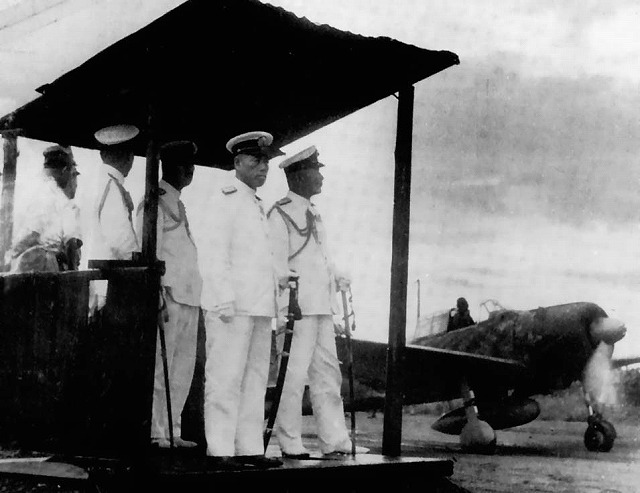 |
How did Japanese and US air force balance change before Operation I? Table shows the loss and supply of aircraft till 10 Febrauary 1943. Japan increased one fourth of US aircraft till 30 September. I think US managed to win supply of aircraft with fewer loss than Japanese. How did USN supply with aircraft? 184 aircraft of the 1st air squadron (Zuikaku, Shokaku and Zuiho) flew to Rabaul from the Truk Atoll on 2 April 1943. Yamamoto directly commanded the 1st air squadron and the 11th air fleet. The air power was 374 aircraft with 190 of 11th air fleet. The IJN aircraft sank an oiler, a destroyer and a corvette at Guadalcanal on 7 April. The IJN aircraft sank a merchant ship at the north of New Guinea on 11 April. On 13 April the air craft sank a merchant ship. During the four day missions, the IJN aircraft sank 5 vessels damaged 31 enemy aircraft only, while IJN lost 43 aircraft. The air battle was called Operation I at Rabaul. The photo shows Yamamoto and Ugaki carried a sword at Rabaul. A sword was a symbol of military officer's authority to soldiers and commons in Japan. I think that Yamamot had to think why MO Operation failed and MI Operation. IJN tried invasion of Port Morsby in the MO Operation and Midway in the MI Operation. The both IJN amphibious operations were blockaded by USN carriers aircraft. Nor IJN had win USN carriers combats once. IJN won against RN in the Indian Ocean. IJN should beat weak RN and Japan should declare free India against the Atlantic Charter by US and UK. IJA had thought global strategy a little. IJN wanted to copmete with IJA simply to get budget. To get much buget, IJN bureaucrats wanted free warship building. Japan should continue Washington Treaty.
Apr07 157 Zeros and 67 carrier bombers attacked Guadalcanal. 12 Zeros and 9 carrier bombers were lost.
Apr11 72 Zeros and 21 carrier bombers attacked New Guinea. 2 Zeros and 4 carrier bombers were lost.
Apr12 131 Zeros and 44 landed bombers Port Morseby. 2 Zeros and 6 landed bombers.
Apr13 191 aircraft attacked the Miln Bay. 8 aircraft was lost.
Japanese & US aircraft balance
| Term | Aug07, 1942
Sep30 | Oct01
Nov15 | Nov16
Feb10, 1943 | Total |
| Japan | Loss | 185 | 195 | 350 |
|
| Supply | 235 | 260 | 475 |
|
| Sub | 50 | 65 | 125 | 240 |
| US | Loss | 110 | 225 | 225 |
|
| Supply | 320 | 360 | 345 |
|
| Sub | 210 | 135 | 120 | 465 |
Yamamoto thought enemy was damaged much. He decided to inspect an airbase on 18 April 1943. Yamamoto was killed by aircraft because of cracking IJN cipher. Why did he plan and action in April? I think he wanted a victory on Mikado's birthday 29 April.
Rabaul kokutai no maturo
Intermission May to October 1943
USN built some air bases in the Solomons Islands. I do not know why USN could ferry supplies. Why were the US convoys safe? The air bases were at Banika Island, New Georgia Island, Vella Lavella Island.
|
250 IJN aircraft were operational in October. Commander of GF, Koga dispatched 173 aircraft of the 1st air squadron. USN landed on Bougainville Island on 1 November. USN task force raided Buka of Bougainville Island on 1 and 2 November. IJN land-based 100 aircraft attacked a US convoy off Bougainville, but no hits. USS Saratoga, Princeton, Essex, Bunkerhill and Independence raided Rabaul on 11 November. Otherwise 33 Zeros, 20 carrier bombers, 14 torpedo bombers and 4 Judies attacked the task force at 0830. The result was miserable. No hits. 24 F4U and 12 F6F intercepted them. The aircraft were controlled by CIC. CIC used radars and wireless phone. And USN used VT fused flaks.
Nov08 100 aircraft attacked US convoys. 15 aircraft were lost.
Nov11 2 Zeros, 17 carrier bombers, all the torpedo bombers and 2 Judies were lost.
Nov12 Koga finished Operation Ro.
The 1st air squadron lost 70% of aircraft. Although IJN lost 60 Zeros at Rabaul in December, it had 120 operational Zeros. But the battle showed IJN air force had no ablity to kill a convoy escorted by surface warships. USN task force showed her fighters could intercept IJN aircraft well by support of radar and wireless phone. The IJN carrier bombers could not break the defense like the Coral Sea and the Midway Battle any more. The newly enemy fighters were pulled up to 2,000 HP.
USN raided the Truk Atoll on 17 February 1944. IJN main surface ships retreated to Palau from Truk. All the aircraft of Rabaul moved to Truk, because Truk could not supply Rabaul.
Action radius of fighters
USN planned advance distance of 300mi in 1942. The distacne was limited by action radius of fighters[14]. Guadalcanal was out of fighter's range from IJN and USN. Why could US choice Guadalcanal as a key stone, when US was busy with Torch Operaion? I think that Port Morsby was good for US to invade Japanese occupied flank. Could US Army offer a good proposal? Why dared Joint Board choice diffcult logistic point? It is US mysterious decision for me even now. I imagine how Japanese head quater was surprised at USN invasion of Guadalcanal. US Marines began glorious history from Guadalcanal since USN had studied amphibious invasion plan in the Pacific by horse for a long time.
[1] Kinugawa maru
[2] 3-ji Solomon kaisen
[3] Kaisen jiten, p112
[4] Gudalcanal tou sakusen
[5] Solomon Kaisen
[6] Nakajima, p124
[7] Nakajima, p100
[8] Chihaya, p224
[9] Action off Bougainville
[10] Rabaul Kohkutai
[11] Morimoto, p170
[12] Rabaul Kohkutai
[13] Rakka zousou
[14] Nimitz, p104
[15] Gudalcanal sen no Gairyaku

aboutMe
© 2008-2011 Enoki Sensor All Rights Reserved
|
